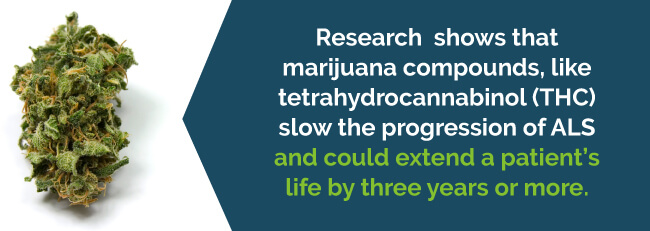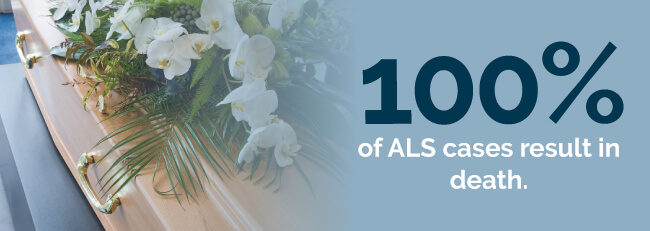Amyotrophic lateral sclerosis (ALS), also known as Lou Gehrig’s disease is a progressive neurodegenerative disease. It affects 6,000 Americans each year, targeting and damaging the nerve cells in your brain and spinal cord. While there is no cure for this disease, medical marijuana for amyotrophic lateral sclerosis has helped slow its progression for patients. Learn more about ALS and how medical weed can make a difference below.
All voluntary movement in the body is controlled by the brain. Nerve cells in the brain, called upper motor neurons, initiate movement through the release of chemical signals called neurotransmitters. The signal is passed from the upper motor neurons to the lower motor neurons of the spine. Nerve fibers extending from the spine, called axons, extend into the muscles. The point where the axons and muscle fibers connect is called the neuromuscular junction. When the signal reaches the neuromuscular junction, it causes the muscle to contract, resulting in voluntary muscle movement. Amyotrophic lateral sclerosis, ALS, often called Lou Gehrig’s disease is a degenerative disease of both the upper and lower motor neurons. As more and more motor neurons become infected, they are unable to send signals or movement to the muscles. Loss of voluntary muscle movement and coordination develop. Over time, muscle weakness and spasticity develop. Patients are unable to perform routine activities, such as walking and getting out of a chair. Eventually paralysis develops, interfering with the ability to swallow, talk and breathe. Unfortunately, there is no cure for ALS. Death from amyotrophic lateral sclerosis usually occurs within three to five years from diagnosis. Learn more below about how medical marijuana can help treat amyotrophic lateral sclerosis.
Studies indicate that medical marijuana for amyotrophic lateral sclerosis could relieve ALS symptoms. Since marijuana is considered a Schedule I drug under federal law, it’s difficult for doctors to research its healing properties.
A review from the American Journal of Hospice and Palliative Care, however, compiled preclinical research covering medical cannabis’ effects on ALS symptoms.
Tests conducted on lab mice suggest that marijuana can reduce inflammation, protect your brain and serve as an antioxidant. These results also bring up the possibility of marijuana helping patients manage other ALS symptoms, like appetite and sleep problems.
The same review also compiled data showing cannabis’ potential to serve a similar purpose as pharmaceuticals in development and on the market. Many prescription drugs aim to improve cell function and brain transmissions to protect the spinal cord. Medical weed could provide the same service, without the harmful side effects of prescription drugs.

Research conducted by the California Pacific Medical Center in San Francisco also shows that marijuana compounds, like tetrahydrocannabinol (THC) slow the progression of ALS and could extend a patient’s life by three years or more. This same research group found that THC can also relieve other ALS symptoms like muscle spasms.
Another discovery by this California research team was that another component of marijuana, cannabidiol (CBD), can enhance THC benefits. Although CBD made no difference by itself, the combination of THC and CBD had even more potential in delaying ALS’ progression.
Research on medical cannabis and amyotrophic lateral sclerosis is promising. As the stigma behind medical marijuana decreases and prohibition lessens, researchers will have the resources to conduct more studies.
Medical marijuana can improve an ALS patient’s quality of life. Many of the symptoms that ALS patients experience, like muscle spasticity, are approved for medical weed treatment.
The muscle stiffness or spasticity caused by amyotrophic lateral sclerosis interferes with your daily life, such as by making walking difficult. Some studies indicate that medical cannabis can help with muscle spasticity and make it easier to live your life.
One of the symptoms associated with ALS, chronic pain, can make living with the disorder challenging. Painkillers might work, but they can hurt your liver and have addictive properties. Medical cannabis enhances the cannabinoids in your body that relieve pain.
ALS patients can also experience a reduced appetite. Many folks joke about medical marijuana causing “the munchies,” but it can give patients the desire to eat. In fact, when combined with cognitive behavior therapy, cannabis can help people with eating disorders have a healthier outlook on food.
A symptom of ALS that you might not consider is its emotional effect. Amyotrophic lateral sclerosis can cause emotional outbursts and those who don’t have them still deal with the mental toll that a terminal illness like ALS puts on someone. For patients dealing with mood problems, especially anxiety and depression, medical weed can provide relief.
Like crops and other plants, medical marijuana comes in varieties known as strains. Each strain has unique qualities and benefits that affect every patient differently. Sometimes, you need to try multiple strains before you find the best one for you.
Medical cannabis strains come in three types — Indica, sativa and hybrid. Indica strains tend to have a relaxing, mellowing effect and are perfect for nighttime use. Sativa strains have an energizing effect and are best for daytime use. Hybrid strains are crossbred and can take on qualities of Indica and sativa.

Marijuana strains that help with muscle problems like spasticity and pain include:
Other strains can help with fatigue. Some examples are:
Some ALS patients experience digestive troubles. There are strains for that, too, like:
Having a terminal illness takes its mental toll. These strains soothe depression and anxiety:
If you need help choosing the right strain, consult with a budtender at your local dispensary. They have the experience and training to answer all your medical cannabis questions!
When most people think of medical marijuana, they imagine someone smoking it. But there’s more than meets the eye! You can consume medical cannabis for amyotrophic lateral sclerosis in many ways, and some of them will work better for you.
ALS manifests differently for every patient. So, we can’t say that one method is the best. However, we can discuss what methods work depending on your symptoms, health profile and personal preferences:
The only people who can decide the best medical marijuana treatment for you are your doctor, budtender and, most importantly, yourself! Everyone has a unique body that reacts differently to medical weed, so your best bet is to experiment with supervision from the experts.
Despite its numerous benefits, medical cannabis isn’t free from unwanted side effects. Here are the most common ones and how to manage them:
It’s rare that patients experience each of these side effects. The most common effects patients experience are hunger, red eyes and dry mouth. Changing your strain or using one that offsets these side effects can make your medical weed usage that much easier.
If you or a loved one has been diagnosed with ALS, medical marijuana can help. We provide a comprehensive database of weed-friendly doctors happy to help you find the best natural cure. We also have a list of dispensaries where you can get the medicine you need. Start your search today so that you can begin relieving your daily ALS symptoms.
Find A Doctor Find A Dispensary
As a neurodegenerative disease, amyotrophic lateral sclerosis kills nerve cells in the brain and the spinal cord. Because ALS interferes with the brain’s control over muscles, the condition hinders all types of movement, including speech, swallowing and breathing. Patients in the later stages of the disease may become paralyzed, and 100 percent of ALS cases result in death.

Three types of ALS exist:
While the type of ALS doesn’t affect your treatment plan, it does provide doctors an understanding of why the disorder developed, such as due to family history.
ALS isn’t a recent discovery in the health community. In fact, it was identified more than 100 years ago. Some facts on its extensive history include the following:

As research for amyotrophic lateral sclerosis continues and we develop a greater understanding of why it develops, a new, eventual fact could be the discovery of an ALS cure.
Physicians may not know why ALS occurs, but they do know why it causes the symptoms that it does — brain and nerve cells are being destroyed. Symptoms of ALS are mild and gradual and include:
Not everyone experiences the same ALS symptoms, and the symptoms progress differently depending on the person. But, every patient deals with paralysis and weakened muscles.
A cure doesn’t exist for ALS, and medicine can’t undo its effects.
According to the ALS Association, folks dealing with ALS survive for three to five years. Only one well-established drug, riluzole, is available for ALS and can extend that time by about two months. However, research suggests that medical cannabis can reduce some amyotrophic lateral sclerosis symptoms, slow the disease’s progress and extend an ALS patient’s life.
Medicine helps with ALS, but therapy can improve your functions and assist with managing your symptoms. Natural treatments used for ALS include cognitive behavioral therapy, speech therapy, breathing therapy, nutritional support, physical therapy and occupational therapy.
For more than 22 years, ALS treatments relied on the medicine riluzole, but with the introduction of a new drug, radicava, in 2017 there are now two prescriptions for ALS available. Let’s take a closer look at them:
While riluzole can protect your brain cells and prevent convulsions, it also has a sedative effect. Other side effects include fatigue, nausea, muscle weakness, digestive issues, appetite loss and headaches. Get in touch with your doctor or go to the emergency room if you experience breathing problems, depression or fever.
Radicava can cause excess bruising, rashes, headaches and problems walking. You should get in touch with a medical professional or head to the hospital immediately if you experience respiratory problems.
Although scientists are making gradual steps toward curing ALS, they have developed some medicines that make it easier to deal with. However, since there are only two medicines out there, you don’t have many choices. But, what if there was a more natural option?